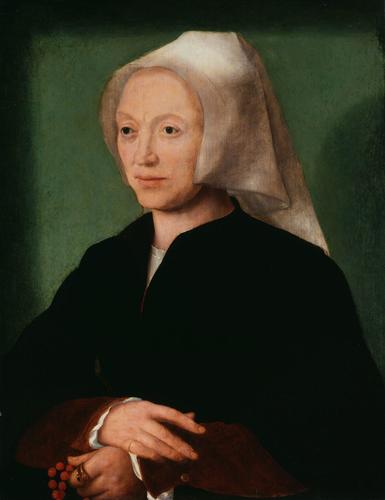-
1 of 253523 objects
Katlijne van Mispelteeren, The Artist's Wife c.1535-40
Oil on panel | 64.7 x 50.3 cm (support, canvas/panel/stretcher external) | RCIN 405779
-
Joos van Cleve was known in Antwerp as a painter of brightly coloured altarpieces; however, until the nineteenth century his paintings were attributed to the ‘Master of the Death of the Virgin’. As a portraitist he was both prolific and talented; historian Francesco Guicciardini (1483–1540) recorded evidence of van Cleve’s sojourn in France to paint portraits for the court of François I. He may then have also visited Italy, apparent from such stylistic elements as the use of sfumato discernible in this portrait, reminiscent of the work of Leonardo.
This painting forms a pair, along with A Portrait of a Man, also in the Royal Collection (see RCIN 405780). The two portraits date to around 1540, after van Cleve’s second marriage, to Katlijne van Mispelteeren. The sitter’s dress resembles those of contemporary portraits by the Master of the 1540s and Jan Vermeyen. She appears to ignore her companion, wearing a look of resigned anticipation suggestive of an Annunciation Madonna, her hands close to her body, her fingers tenderly caressing a rosary. The blue veins snaking beneath her diaphanous skin demonstrate van Cleve’s talent for rendering flesh. There is a pictorial predecessor to this portrait in Gossart’s Portrait of a Woman of 1520–25 (Gemäldegalerie, Berlin), although the hands are not shown as the bottom fifth of the painting is missing. However, a copy of that portrait in the Lobkowicz Collection reveals that the angle of the head, the position of the clothing and the placement of the fingers are almost identical to the Royal Collection painting. It is possible that the two portraits by Gossart formed a pair from which van Cleve took inspiration.
The background of the two paintings in the Royal Collection is plain green and both figures are dressed in dark, sober garments, the black of the man’s hat complementing the starched whiteness of the woman’s headpiece. The artist experiments with illusionistic conceits by including strong shadows behind the sitters. These not only unite the two by indicating that they are lit from the same source, they are also employed to trick the viewer by throwing shadows of the picture frames onto the background, blurring the boundaries of reality and fiction.
Text adapted from Bruegel to Rubens: Masters of Flemish Painting, London, 2007, and Portrait of the Artist, London, 2016Provenance
Acquired by Charles I in 1636; recorded with its pair (405780) in the King's Chair Room at Whitehall in 1639 (nos 13 & 15); both sold together for £61 to Wright on 21 May 1650 from St James's Palace (no 120); recovered at the Restoration and listed in the King's Dressing Room at Hampton Court in 1666 (no 30 & 34)
-
Creator(s)
Acquirer(s)
-
Medium and techniques
Oil on panel
Measurements
64.7 x 50.3 cm (support, canvas/panel/stretcher external)
92.5 x 77.8 x 11.5 cm (frame, external)
Category
Object type(s)
Other number(s)
Alternative title(s)
Portrait of the artist's wife, previously entitled
